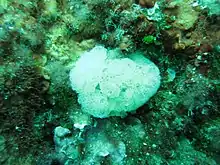Polyclinum aurantium
Polyclinum aurantium is a species of colonial sea squirt, a tunicate in the family Polyclinidae. It is native to shallow water in the northeastern Atlantic Ocean and Mediterranean Sea.
| Polyclinum aurantium | |
|---|---|
 | |
| Polyclinum aurantium | |
| Scientific classification | |
| Kingdom: | |
| Phylum: | |
| Subphylum: | |
| Class: | |
| Order: | |
| Suborder: | |
| Family: | |
| Genus: | |
| Species: | P. aurantium |
| Binomial name | |
| Polyclinum aurantium (Milne-Edwards, 1841)[1] | |
| Synonyms | |
| |
Description
Polyclinum aurantium forms globular or flat-topped mounds consisting of a number of zooids immersed in a common tunic. Each zooid has its own buccal siphon with six lobes, through which it draws in water, and the colony has a small number of common cloacal siphons, each with a long tongue-like projection, through which water is expelled. The individual zooids are up to 6 mm (0.24 in) long, and the colony is yellowish-brown or yellowish-grey and often coated with sand.[2]
Distribution and habitat
Polyclinum aurantium is native to the northeastern Atlantic Ocean. Its range extends from Norway southwards to the Mediterranean Sea. It occurs on rocks and other hard substrates at depths down to about 100 m (328 ft).[2]
References
- Sanamyan, Karen (2014). "Polyclinum aurantium Milne Edwards, 1841". WoRMS. World Register of Marine Species. Retrieved 2015-02-05.
- de Kluijver, M.J.; Ingalsuo, S.S. "Polyclinum aurantium". Macrobenthos of the North Sea: Tunicata. Marine Species Identification Portal. Retrieved 2015-02-05.